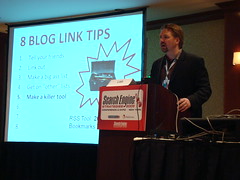 Do you have a blog? If so, a panel today at SES NY shared how to improve SEO results with your blog and its RSS Feed.
Do you have a blog? If so, a panel today at SES NY shared how to improve SEO results with your blog and its RSS Feed.
Michael Gray, Owner of Atlas Web Service, shared the following tips to increasing SEO value with your blog.
1. Don’t write blog titles that suck
Bad titles lack keyword focus, are often clever or amusing and therefore not intuitive to a reader or search engine.
Good titles include keywords and are focused on topics covered within the post.
2. Partial feeds are like being half dressed at a party
Why do you want to use full feeds or be fully dressed?
Full feeds allow you to benefit from web scrapers and build links for you. Make sure you put keyword optimized hyperlinks within your post, specifically to pages that are more difficult to build Links to.
3. Build domain authority with a blog
By putting your blog on a sub-domain or sub-folder on your domain, you are able to consolidate Link equity.
4. Stand out and be Link worthy
Don’t blog for the sake of blogging. Have a purpose.
Blog at whatever frequency allows you to be exceptional. The longer the time period between posts, the more exceptional you have to be.
Have an opinion, be serious, be funny, be politically incorrect, be a moral compass – be something.
5. Just because you blog, doesn’t mean they will visit
Michael shares that great writing without shameless self promotion is like locking Shakespeare in your basement. 🙂
Leverage your network, before and after the post goes live, to help promote your content. Make sure people know who you are. Connect with other influential bloggers. Start by Linking to and/or commenting on their blog.
Next is TopRank Marketing CEO, Lee Odden, who takes the audience through building Inbound Links to your blog, in turn creating increased search engine visibility. 
How do you organically build Links? Follow these 8 Tips:
1. Tell your friends
Give them a reason to link to you and read your blog.
2. Link out
Blog software will often fire off an email when someone Links to your blog. Link to influentials and at the very least get on their radar. Don’t Link for Links sake, but do it with purpose and to provide value.
3. Make a big ass list
Check out the TopRankBlog BIGLIST. It currently has just under 60,000 Inbound Links.
4. Get on ‘other lists’
Make comments on other blogs in a way that adds value and gets you noticed. Once you get on one list, publicize that publicity and you’re likely to get on multiple lists
5. Make a killer tool
For example, an RSS Tool created by TopRank Marketing SEO Guru, Thomas McMahon, has over 260,000 Inbound Links.
6. Run a contest or poll
Give recognition to a useful tool while letting the community interact and engage. Or run a poll and create a badge for the winner, which gets placed on their site and Links back to your blog.
Create a badge page and make it easy for someone to upload the badge to their site, with a Link back to you.
7. Get Syndicated
Getting syndicated, in an intentional way, to create Inbound Links back to the blog. Collectively, the Inbound Links add up.
8. Network OFFLINE
Make it obvious what your blog is. Print your blog URL everywhere you list your phone number or website.
BONUS Tip.
Dynamically embed a Link to the post in your RSS Feed.
Key Takeaways:
- Give blogs a reason to Link
- Remember the golden rule
- Don’t obsess, focus on value
- Quality is better than quantity
(but quantity has a quality of its own)
Next up is Michel Leconte, CEO of SEO Samba.
Search engines, including Google, pay attention to relevancy, freshness and quantity.
Build up RSS Feed subscribers by writing content, re-purposing existing content and distributing. Gain traffic and juice by deep Linking.
Distribute broadly by formatting, promoting latest posts and by dicing content into categories and interest.
Make subscribing to an RSS feed easy with:
- One click subscriptions
- Email subscription
- Auto discovery tag
- RSS directories
Audience Q&A
Question: What about Linking within comments?
Answer: Oftentimes the Links are no follow, so it may not be useful for building Inbound Links but commenting is useful in networking with other blogs and providing value to the conversation.
Question: What about news blogs that don’t have time to do more than post press releases? How do you get additional coverage for the news content?
Lee spoke to the idea of discovery. Identify which news sites you would like coverage on and then make your content discoverable to the influentials.
You can do this by networking with people already getting covered on the site or network with the decision maker directly.
Michael added that you can check out other aggregating sites and identify who is submitting content relevant to your topic or vertical and begin by networking with them. They can become a great resource to getting your content more exposure.
If you have more tips on creating SEO value through blogs and RSS Feeds, please share below.
Additional coverage of this session can be found at:
Outspoken Media – Lisa Barone
Search Cowboys – Bas van den Beld


